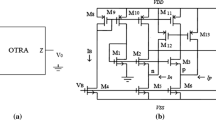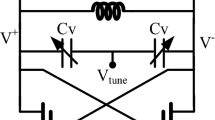Abstract
In the design of the common base Colpitts oscillator, the resistance values of Thevenin’s resistors significantly influenced the transient time and steady state response of the resulting circuit. Various traditional approaches such as intuitive reasoning, mathematical calculation, and simulation-based techniques have been proposed in the literature for this purpose. Some of the aforementioned techniques involve rigorous mathematics, intuition, and experimentation in determining appropriate component values for optimal performance, stable steady state performance, and short transient response time from the resulting oscillator. In this paper, a new method of designing Colpitts oscillator using hybrid artificial intelligence comprising evolutionary-based Genetic Algorithm (GA) and artificial neural network (ANN) has been proposed. GA has been used in selecting various optimum resistance values of Thevenin’s resistors for maximizing long-term stability of the output waveform thus ensuring stable steady response of the designed circuit. ANN has been utilized in learning the nonlinear relationship between Thevenin’s resistors and transient time response of the Colpitts oscillator. Upon ANN convergence, optimum resistance values of obtained from GA process are fed into the trained ANN in predicting transient response time of each circuit. Optimized values with the shortest transient response time are finally selected for the Colpitts oscillator. The designed circuit successfully achieved optimization between its transient time response and steady state response. Hence, successfully reducing computation associated with existing traditional techniques in designing similar optimum Colpitts oscillator and achieving stable steady state output. Furthermore, this work has also demonstrated that ANN is capable of predicting the transient time of circuit with reasonable accuracy.





















Similar content being viewed by others
References
Aggarwal, V. (2003). Evolving sinusoidal oscillators using genetic algorithms. In Proceedings of the 2003 NASA/DoD Conference on Evolvable Hardware, Chicago, USA, pp. 67–76.
Ardali, S. R., Samani, S. G., & Arzanifar, B. (2011). Oscillation amplitude analysis of MOS Hartley oscillator using a general model. Journal Integrated Circuits and Systems, 6, 60–67.
Baek, S., Lee, G. S., Lee, K., & Jee, Y. (2011). Multi-band active integrated antenna using Clapp oscillator circuit. In IEEE 6th International Conference on Telecommunication Systems, Services, and Applications (TSSA), pp. 69–72.
Bakshi, U. A., & Godse, A. P. (2009). Analog electronics. Pune: Technical Publication.
Canham, R. O. & Tyrrell, A. M. (2002). Evolved fault tolerance in evolvable hardware. In Proceedings of the 2002 Congress on Evolutionary Computation, Vol. 2, pp. 1267–1271.
Chu, C., Ke, B. & Chiu, H. C. (2012). The body driven low phase noise injection-locked V-band push–push complementary-Colpitts oscillator. In 4th International High Speed Intelligent Communication Forum (HSIC), pp. 1–2.
Crecraft, D., & Gergaly, S. (2002). Analog electronics: Circuits, system and signal processing. London: Butterworth-Heinemann.
Fozdar, M., Arora, C. M., & Gottipati, V. R. (2007). Recent trends in intelligent techniques to power systems. In UPEC, pp. 580–591.
Gallo, G., Osorio, G., & Olivar, G. (2012) Event-driven simulation of Filippov systems: The case of a nonlinear Wien bridge oscillator. In IEEE Third Latin American Symposium on Circuits and Systems (LASCAS), pp. 1–4.
Hongbing, Y., & Qixing, C. (2012). Various behaviors of Wien-Bridge circuit and quasi-Wien-Bridge circuit in different situations. In IEEE Spring Congress on Engineering and Technology (S-CET), pp. 1–4.
Huelsbergen, L., Rietman, E., & Slous, R. (1999). Evolving oscillators in silicon. IEEE Transactions on Evolutionary Computation, 1(3), 197–204.
Jinho, P., Kiyong, C., & David, J. A. (2004). Parasitic-aware RF circuit design and optimization. IEEE Transactions on Circuits and Systems-I, 51, 1953–1966.
Juan, L. M., & Rafael, M. G. (2012). Asymptotic synchronization of the Colpitts oscillator. Computers and Mathematics with Applications, 63, 1072–1078.
Kazimierczuk, M. K., & Dakshina, M. B. (2010). Loop gain of the common-drain Colpitts oscillator. International Journal of Electronics and Telecommunications, 56(4), 423–426.
Kruikamp, W., Leenaerts, D. (1995) Drawin: CMOS Opamp synthesis by means of genetic algorithm. In 32nd Design Automaion Conference, CA, USA, pp. 433–438.
Kumar, S., Kadia, B., Singh, R., Varia, A., Srinivas, Y. S. S., Kulkarni, S. V. (2010). Design aspects of 13.56 MHz, 1 kW, CW-RF oscillator for plasma production. In 23rd National Symposium on Plasma Science & Technology (PLASMA-2008), Vol. 208, pp. 1–4.
Litovski, V. B. (1992). MOS Transistor Modeling Using Neural Networks. Electronic Letters, 28(18), 1766–1768.
Litovski, V. B., Mréarica, Z., & Ilić, T. (1997). Simulation of non-linear magnetic circuits modeled using artificial neural network. Simulation Practice and Theory, 5, 553–570.
Miranda, V., Srinivasan, D., & Proenca, L. M. (February 1997). Evolutionary computations in power systems. International Journal of Electrical Power & Energy Systems, 20(2), 89–98.
Mitchell, M. (1996). An introduction to genetic algorithms. Cambridge: MIT Press.
Sen, P., Pratap, R. J., Mukhopadhyay, R., Sarkar, S., Lee, C. H., Pinel, S., May, G. S., & Laskar, J. (2006). Neuro-genetic design centering of millimeter wave oscillators. Silicon Monolithic Integrated Circuits in RF Systems, pp. 4–5.
Song, Y. H., & Johns, A. T. (1997). Applications of fuzzy logic in power systems, Part 1 General introduction to fuzzy logic. IEEE Power Engineering Journal, 11(5), 219–222.
Sushanta, K., Mandal, S. S., Amit, P. (2008). ANN- and PSO-based synthesis of on-chip spiral inductors for RF ICs. In IEEE Transactions on Computer aided Design of Integrated Circuits and Systems, Vol. 27, pp. 188–192.
Taylor, J., & Clarke, C. (2008). Improved harmonic analysis of RC-active phase shift oscillators. In IEEE International Symposium on Circuits and Systems, pp. 1272–1275.
Wen, W., Yilong, L., Jeffrey, S. F., & Yong, Z. (2005). Particle swarm optimization and finite-element based approach for microwave filter design. IEEE Transactions on Magnetics, 41, 1800–1803.
Zehulum, R. S., Pacheco, M. A., & Vellasco, M. (1998) A multi-objective optimization methodology applied to the synthesis of low-power operational amplifiers. In Proceedings of the XIII International Conference in Microelectronics and Packaging, August 12–14.
Zhang, J., Shi, Y., & Zhan Z. (2008). Power electronic circuits design: A particle swarm optimization approach. In Proceedings of the 7th International Conference on Simulated Evolution and Learning, pp. 605–614.
Author information
Authors and Affiliations
Corresponding author
Rights and permissions
About this article
Cite this article
Amsa, M.G.B.A., Aibinu, A.M. & Salami, M.J.E. A Novel Hybrid Artificial Intelligence Technique for Colpitts Oscillator Design. J Control Autom Electr Syst 25, 10–21 (2014). https://doi.org/10.1007/s40313-013-0084-4
Received:
Revised:
Accepted:
Published:
Issue Date:
DOI: https://doi.org/10.1007/s40313-013-0084-4




